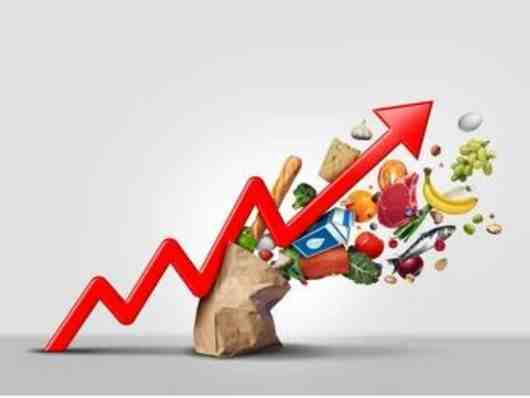Prices of goods and services have evolved over time, and this has always had an impact on a country’s economy. While inflation has some advantages, it can also have some disadvantages that exclude some people. To calculate it, apply the formula for the inflation rate. Find out what causes inflation, why goods and services cost more, and how to control it.
Inflation
When the prices of goods and services increase over time, it is said to be a gradual loss of purchasing power. The average price increase of a selection of products and services over time can serve as a proxy for the rate at which buying power declines. A unit of currency effectively buys less as a result of the increase in pricing, which is sometimes stated as a percentage. Deflation, happens when prices fall and buying power rises.
What Is Inflation
The term “inflation” refers to a rise in prices, which over time results in a loss of purchasing power. The average price increase of a basket of chosen goods and services over time can be used to determine the rate at which buying power is decreasing. A unit of currency effectively buys less as a result of the increase in pricing, which is sometimes stated as a percentage.
Inflation Example
An example of inflation is the cost of milk. A gallon of milk cost approximately 36 cents in 1913. A gallon of milk cost $3.53 in 2013, roughly 10 times more than it did one hundred years earlier.
This rise is not a result of milk being more expensive or less accessible. In actuality, the reverse is true. Instead, this price indicates inflation’s progressive erosion of the purchasing power of money.
- To determine how much the cost of that particular commodity or service has changed, subtract A from B.
- The result will become a decimal number when you divide it by A (the beginning price).
- The decimal number should be multiplied by 100 to become a percentage. The rate of inflation is the outcome!
How to Calculate Inflation Rate
According to economists, this is the simplest method to calculate a general estimate of your personal annual inflation rate.
Finding out how much of your expenditure comes into several categories or buckets, such as entertainment, food, energy, clothing, and housing, is the first step.
You’ll need to look up the precise spending amounts for the prior year in your bank and credit card accounts in order to achieve this. You can itemize your purchases by category with the help of a complete list that is published by the U.S. Bureau of Labor Statistics.
Do the math for your category “weights.” This weighting essentially represents the portion of your budget that is allocated to certain buckets. (This weighting is referred to as “relative relevance” by the consumer price index.)
Example:
An example on how to calculate inflation.
Add up all of your spending across all categories to complete this. To get the category weight, divide each amount by your total annual spending.
Let’s imagine that from May 2021 to May 2022, a household spent $50,000 overall. Mr. A spent $17,000 on rent, or 34% of the total, and $6,000 on groceries, or 12%. Their respective category weights would be 0.34 and 0.12.
See once more the detailed expenditure category table from the BLS. The average annual per cent price rise for each item is displayed in the “unadjusted per cent change” column.
For instance, during the year ending in May, rent payments grew by 5.5%. In the same time frame, the cost of domestic food (groceries) increased by 11.9%.
- Multiply the step 3 annual per cent change for each category by the step 2 category weights. For the rent computation, multiply 0.34 by 5.5 using the example from above. For food, multiply 0.12 by 11.9 Likewise for all other types of spending.
- Add the category totals from step 4 to get your own rate. (In the previous illustration: 1.87 + 1.428 + etc.) Your annual rate is indicated as a percentage of this sum.
Compared to the national average, compare your rate. A percentage lower than 8.6% for annual spending through this May indicates that your costs haven’t climbed as much as the average American’s have.
If the number is larger, your expenses have increased more during the past year. In fact, households frequently use money instead of percentages when making decisions.
Causes of Inflation
The main causes of inflation can be grouped into three broad categories:
- Demand-pull,
- Cost-push
- Inflation expectations.
Demand-pull , as its name implies, is brought on by changes in the demand side of the economy, whereas cost-push is brought on by the impact of rising input costs on the supply side. The concept of ” expectations” refers to the idea that what people and businesses anticipate will happen to prices in the future might affect those prices in the real world.
#1. Demand-pull Inflation
Demand-pull occurs when the overall demand for goods and services (also known as “aggregate demand”) climbs to a level where it exceeds the total supply of goods and services (also known as “aggregate supply”) that can be produced sustainable. A increase in demand ultimately causes an increase in inflation, or “pulls” it higher, by exerting upward pressure on prices across a wide range of products and services.
#2. Cost-push Inflation
Cost-push happens when the economy’s aggregate supply—the total amount of goods and services that can be produced—declines. A rise in the cost of manufacturing is frequently the root cause of a decline in aggregate supply. Prices are under pressure to rise, or inflation is “pushed,” if overall supply declines but overall demand does not.
#3. Inflation Expectations
Household’s and businesses expectations regarding price rises in the future are known as inflation expectations. They are crucial because they might have an impact on the present-day economic choices. For instance, businesses may increase the price of their goods and services more quickly if they act on the notion that in the future it would be higher. Similarly to this, if employees anticipate higher inflation in the future, they can ask for higher pay to make up for the anticipated loss of their purchasing power.
Inflation is caused by a rise in the supply of money, albeit this can happen through a variety of economic causes. Some other causes of inflation include
- Printing additional currency and distributing it to people
- Legally depreciating (decreasing) the value of the money that is legal tender
- Acquiring government bonds from banks on the secondary market in order to create new money as reserve account credits through the banking system (the most common method)
Advantages and Disadvantages of Inflation
Inflation has its advantages and disadvantages. High inflation rates are typically thought to be detrimental to an economy. It can cause uncertainty and reduce the purchasing power of savings. Yet, the majority of Central Banks aim for inflation rate of 2%, indicating that low inflation can have a number of positive effects on the economy.
Advantages
The economy can benefit from
#1. Adjusting Wages Is Made Possible
It is suggested that relative pay adjustments are made simpler with a moderate rate. For instance, it might be challenging to reduce nominal wages (workers resent and resist a nominal wage cut). But, if mild inflation is driving up average salaries, it will be simpler to raise the pay of productive people while freezing the pay of unproductive workers, which basically amounts to a real wage reduction. If there was no inflation, businesses could be unable to lower pay to attract workers, which could lead to increased real wage unemployment.
#2. It May Encourage Growth.
The economy may be in a recession when inflation is extremely low. It might be argued that increasing the inflation target can lead to faster economic growth. This point of view is divisive. Not all economists would be in favor of aiming for higher inflation. Some, though, would aim for higher inflation if the economy remained mired in a protracted downturn.
#3. Relative Pricing Can Be Adjusted
Similar to the previous point, moderate inflation facilitates relative price adjustments. For an area with a single currency, like the Eurozone, this is especially crucial.
Greece, Spain, Italy, and other southern European nations lost their competitiveness, which resulted in a significant current account imbalance. Spain and Greece must reduce relative prices in order to recover competitiveness because they are unable to devalue in the Single Currency. Europe has exceptionally low inflation, which forces price and wage reductions that slow economic growth (due to the effects of deflation). It would be simpler for southern Europe to adapt and restore competitiveness without turning to deflation if the Eurozone experienced moderate inflation.
#4. Deflation is Preferable to Inflation.
Economists quip that deflation is the only thing worse than inflation. A decrease in prices has the potential to increase the real debt load while discouraging investment and consumption. The 1930s Great Depression included deflation as one of its causes.
Disadvantages
When inflation rates exceed 2%, it becomes a problem. The severity of the issue increases with inflation. Hyperinflation can wipe out people’s savings and lead to significant instability in dire situations. Yet, this form of hyperinflation is uncommon in a modern economy. Inflation is typically comes with an increase in interest rates, protecting savers from having their money wiped out. Nonetheless, issues can still arise from inflation.
- Unsustainable inflationary expansion usually results in a harmful era of boom and bust economic cycles.
- Inflation discourages long-term economic growth and investment This is due to the confusion and ambiguity that are more likely to develop during times of high inflation. It is believed that low inflation promotes better stability and encourages businesses to invest and take risks.
- An economy may become uncompetitive due to inflation.
- A decline in the worth of money is a result of inflation. If inflation is higher than interest rates, savers are worse off. A rise in inflation may cause income redistribution in society.
Pensioners frequently suffer the most from inflation. If interest rates are low and inflation is high, this is especially problematic.
What Are the 3 Main Causes of Inflation?
The main causes of inflation can be grouped into three broad categories:
- Demand-pull.
- Cost-push.
- Inflation expectations
READ ALSO PRODUCER PRICE INDEX
What Is Causing Inflation in the US?
When the economy sprang out of the pandemic slump two years ago, supply chain bottlenecks and parts shortages drove up the price of manufactured goods. Then, federal stimulus checks caused a spike in consumer spending. Later, as a result of Russia’s invasion of Ukraine, gas and food supplies were disrupted, driving up costs.
The Federal Reserve has been aggressively boosting interest rates since March in an effort to curb price peaks.
How Can We Stop Inflation?
Controlling the amount of money in the economy is an important monetary approach to combat inflation. The demand for things will decline and prices will fall if the money supply declines. When the government removes particular coins or paper money from circulation, this is another technique to reduce the amount of money in circulation.
Who Benefits from Inflation?
In the field of economics, inflation is the long-term, steadily rising level of prices for most products and services across an economy. It results from a decrease in productivity and an increase in the money supply.
Debtors benefit the most from inflation since more individuals need to borrow money from them to keep up with rising commodity costs.
How Can We Reduce Inflation?
One frequent strategy for managing inflation is to implement a contractionary monetary policy. A contractionary strategy lowers bond prices and raises interest rates in an effort to reduce the amount of money available in the economy. As a result, prices drop, inflation slows, and consumption declines.
What Happens After Inflation?
The main cost of inflation is the erosion of real income, which occurs when prices rise unevenly and cause some customers’ purchasing power to decline. For both those who receive and pay fixed interest rates, inflation might over time affect their ability to make purchases.
Will Inflation Go Down?
The weakening economy should have lowered the annual inflation rate to about 3.5%–4.0%, but this will still be higher than the Federal Reserve’s goal range of 2.0%–2.5%.
Is Inflation Worse for the Rich or Poor?
The outcomes are comparable, with the annual average rise being quite close overall and the inflation rate among low-income households being higher than that among high-income households.
What Should I Invest in During Inflation?
Here is where financial gurus advise investing during a period of high inflation.
- Treasury Inflation-Protected Securities
- Short-term bonds
- Stocks
- Real estate
- Gold
- Commodities
- Cryptocurrency
In Conclusion,
Although inflation can cause disastrous event like lowering the economy, it also offers a lot of benefit.
FAQs
Who makes the most money during inflation?
A few equity sectors have resisted or outperformed growing inflation predictions, despite the fact that most equity sectors typically suffer during rising inflation. These are a few examples.
- Wine
- Real Estate
- Energy
- Bonds
- Financial Companies
- Commodities
- Healthcare
- Consumer Staples
What are effects of inflation?
As prices rise, your purchasing power decreases due to inflation. Moreover, pensions, savings, and Treasury notes lose value due to inflation. Real estate and collectibles are examples of assets that typically stay pace with inflation. During an inflationary period, variable interest rates on loans rise.
Related Articles
- WHERE TO INVEST DURING INFLATION: Best 2023 Investments, Revealed!(
- WHY INVESTMENT IS IMPORTANT: In Business & Future Life
- ARE BONDS A GOOD INVESTMENT Right Now in 2023?(
- Do Interest Rates Affect The Stock Market? How and Why?
- BEST TIPS ON HOW TO FIGHT INFLATION IN 2023






